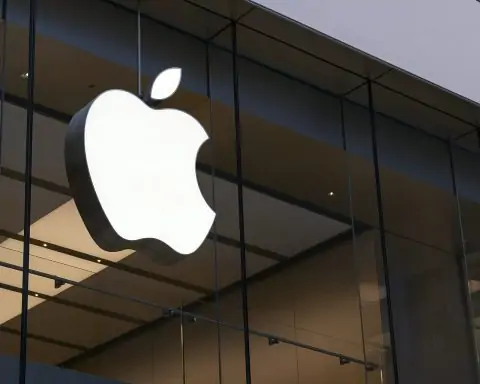Verizon Communications Inc. (NYSE: VZ) is back in the spotlight this weekend after a dramatic week that combined a new CEO, plans for more than 13,000 job cuts, and a stock price that is quietly grinding higher.
As of the close on Friday, November 21, 2025, Verizon stock finished at $41.23, up roughly 1.1% on the day, with an intraday range of $40.42–$41.61 and a 52‑week range of $37.59–$47.36. [1]
At that price, Verizon carries an annual dividend of $2.76 per share, implying a dividend yield of about 6.7–6.8%, and trades at roughly 8.7–8.8x trailing earnings, well below its 10‑year average valuation. [2]
Layer on top the company’s biggest restructuring in years and a CEO fresh from PayPal, and Verizon has suddenly become one of the most talked‑about income and value stocks on Wall Street.
Key takeaways for Verizon stock today
- VZ closed at $41.23 on Friday, up about 1.1%, with trading activity elevated versus typical daily volume. [3]
- New CEO Dan Schulman, formerly CEO of PayPal, was appointed in October 2025 to replace Hans Vestberg. [4]
- Verizon is cutting more than 13,000 jobs, its largest single layoff ever, and plans to franchise or reshape parts of its retail footprint as part of a broad cost‑cutting drive. [5]
- Q3 2025 results were steady: revenue grew 1.5% year‑on‑year to $33.8 billion, with adjusted EPS of $1.21 and strong free cash flow, and full‑year guidance was reaffirmed. [6]
- The dividend remains central to the investment story: Verizon has raised its payout for 19 consecutive years and currently yields around 6.7–6.8%. [7]
Verizon stock today: price snapshot and valuation
Verizon shares closed Friday, November 21, 2025 at $41.23, up from a previous close of $40.76, a gain of roughly 1.1%. Intraday, the stock traded between $40.42 and $41.61, which sits comfortably in the middle of its 52‑week range of $37.59 to $47.36. [8]
At this level:
- Dividend yield: about 6.7–6.8%, based on an annual dividend of $2.76 per share. [9]
- Trailing P/E ratio: around 8.7–8.8x, significantly below Verizon’s 10‑year average P/E near 11–12x and lower than many large‑cap peers in the broader market. [10]
- Market capitalization: approximately $172–174 billion. [11]
From a pure numbers perspective, Verizon currently screens as a high‑yield, low‑P/E blue chip with a big cash payout, modest growth, and a heavy dose of restructuring risk.
Why Verizon is back in focus: New CEO Dan Schulman
Part of the renewed attention on VZ stems from leadership change at the top.
On October 6, 2025, Verizon’s board appointed Dan Schulman – best known for leading PayPal’s transformation into a global digital payments platform – as Chief Executive Officer, succeeding Hans Vestberg. [12]
Key points about the new CEO:
- Schulman previously tripled PayPal’s revenue and significantly expanded its user base, earning a reputation as a tech‑savvy, execution‑minded leader. [13]
- He has served on Verizon’s board since 2018, so he’s not coming in cold; he knows the company and its challenges. [14]
- His early public comments and internal memos emphasize “reinvention,” cost discipline, and a sharper customer‑first culture. [15]
Investors now view Verizon as a turnaround and transformation story, not just a slow‑growing income stock. Schulman’s first major move: a sweeping cost‑cutting and restructuring plan that includes the largest layoffs in company history.
13,000+ job cuts and a “scrappier” Verizon
Verizon’s biggest headline this week is its decision to cut more than 13,000 jobs as part of a large restructuring initiative under Schulman. [16]
According to multiple reports and company communications:
- The cuts represent roughly 13–15% of the workforce, depending on which final figure (13k+ vs. up to 15k) is used across various reports. [17]
- The layoffs are focused heavily on management and non‑union roles, accounting for about 20% of the company’s management workforce, and are being phased in starting this week. [18]
- Verizon also plans to convert around 179–200 corporate‑owned stores into franchise locations and close at least one store, shifting more of its retail footprint to partners to reduce fixed costs. [19]
- The company has set up a $20 million Reskilling and Career Transition Fund aimed at helping affected employees retrain, including for roles that may emerge in the age of AI and more digital operations. [20]
Schulman’s rationale, laid out in a memo to staff and reinforced on earnings calls, is straightforward: Verizon’s cost structure and organizational complexity make it harder to invest aggressively in customer experience, network quality, and new growth areas. [21]
For Verizon stock, large layoffs have two competing implications:
- Short‑term: lower operating expenses should support margins and free cash flow, which matters a lot to income investors focused on the sustainability of that nearly 7% dividend.
- Medium‑term risk: big restructuring programs carry execution risk, can weigh on morale, and sometimes signal that organic growth is under pressure.
So far, the market reaction has been mixed but not panicked. Early headlines suggested a modest pullback on the layoff news, but by Friday, VZ shares were trading higher, and volume was significantly above average as traders weighed the long‑term impact. [22]
How the business is performing: Q3 2025 earnings in focus
Beyond the headlines, Verizon’s actual operating performance still matters most for the stock’s long‑term path.
In its Q3 2025 earnings release (October 29), Verizon reported: [23]
- Total operating revenue: $33.8 billion, up 1.5% year‑over‑year.
- GAAP EPS: $1.17, up sharply from $0.78 a year earlier.
- Adjusted EPS: $1.21, slightly above the prior year’s $1.19 and ahead of many analyst estimates. [24]
- Operating cash flow (9 months): $28.0 billion, up from $26.5 billion in the same period of 2024.
- Free cash flow (9 months): $15.8 billion, versus $14.5 billion a year ago.
- Debt reduction: total unsecured debt fell to $119.7 billion, with net unsecured debt at $112.0 billion.
On the wireless and broadband side, Q3 data showed:
- Wireless service revenue: $21.0 billion, up 2.1% year‑over‑year, an industry‑leading figure by revenue scale. [25]
- Consumer wireless service revenue: up around 2.4%, helped by higher average revenue per account (ARPA) and bundling. [26]
- Fixed wireless and Fios fiber broadband: continued to add subscribers, with fixed wireless subscribers at nearly 5.4 million and Fios recording its strongest quarter of broadband net adds in about two years. [27]
- Subscriber pressure: Verizon still lost about 7,000 postpaid phone subscribers, while rivals like T‑Mobile added far more, underlining the intense competitive environment. [28]
Despite those mixed signals, Verizon reaffirmed its full‑year 2025 guidance, expecting: [29]
- Wireless service revenue growth of 2.0–2.8%
- Adjusted EBITDA growth of 2.5–3.5%
- Adjusted EPS growth of 1.0–3.0%
- Operating cash flow of $37–39 billion and free cash flow of $19.5–20.5 billion
In other words: slow, steady growth, strong cash generation, and a lot of emphasis on “fixing the house” rather than chasing flashy new revenue streams.
Dividend remains central to the Verizon investment story
For many investors, Verizon stock is first and foremost a dividend play.
According to company and market data: [30]
- Verizon pays an annualized dividend of $2.76 per share, typically in four quarterly installments.
- The most recent quarterly dividend was $0.69 per share, paid on November 3, 2025, following an ex‑dividend date of October 10, 2025.
- The current indicated yield is about 6.7–6.8%, one of the higher yields among large‑cap U.S. telecoms and dividend “blue chips.”
- Verizon has increased its dividend for 19 consecutive years, placing it firmly among long‑tenured dividend growers.
The payout ratio, at around 58% of earnings, leaves some room for reinvestment and debt reduction, although Verizon’s large absolute debt load means management must balance dividend commitments with balance‑sheet discipline. [31]
For income‑focused investors, the key questions now are:
- Will Schulman’s cost cuts and strategic shifts protect or enhance free cash flow, making the dividend safer?
- Or does a large restructuring signal a riskier backdrop that could eventually pressure the payout if competitive or regulatory conditions worsen?
So far, management’s messaging has been clear: the dividend is a priority, and cost savings are intended to support, not undermine, shareholder returns.
Is Verizon stock cheap? How the market is valuing VZ
On classic valuation metrics, Verizon currently screens as cheap relative to history and to many parts of the market, though not necessarily cheap relative to all telecom peers.
Key valuation snapshots: [32]
- Trailing P/E: about 8.7–8.8x, versus a 10‑year average above 11x.
- Forward P/E: roughly 8.5–9.0x, based on consensus earnings estimates. [33]
- Enterprise value to EBITDA: around 6.8x, sitting in a reasonable range for a mature telecom with stable cash flows. [34]
On the Street, many analysts still take a cautious stance:
- A recent snapshot from MarketBeat shows a consensus “Hold” rating, with a mix of “Buy,” “Hold,” and a small number of “Strong Buy” ratings.
- The average 12‑month price target sits in the mid‑$40s (around $47), implying moderate upside from current levels if execution goes well. [35]
That combination – low P/E, high yield, but only modest growth and plenty of debt and competitive pressure – is why VZ is often labeled a potential “value stock” that could either be:
- a bargain, if Schulman’s transformation unlocks growth and efficiencies, or
- a value trap, if competition and capital intensity keep returns subdued despite the low multiple. [36]
Strategy and growth: beyond cost cutting
While layoffs and cost controls are front and center, Verizon is also investing in strategic initiatives that could shape growth over the next decade.
A few notable themes:
- Network and fiber expansion: Verizon continues to invest in 5G, fixed wireless, and Fios fiber, including a strategic fiber partnership with Tillman Global Holdings aimed at expanding its footprint outside traditional markets. [37]
- Space‑based connectivity: Verizon has partnered with AST SpaceMobile to deliver space‑based cellular coverage in underserved areas, combining its 850 MHz spectrum with satellite‑driven service – a potential differentiator in rural and remote markets. [38]
- Digital health and new verticals: Recent collaborations, such as one with Validic on connected health solutions for older adults, highlight Verizon’s push to build emerging revenue streams in digital healthcare and IoT‑driven services. [39]
- Transformation leadership: Verizon has appointed a Chief Transformation Officer, Alfonso Villanueva, to help drive the multi‑year restructuring and operational overhaul. [40]
These initiatives don’t move the needle overnight, but they show that Schulman’s Verizon is not only cutting costs – it’s also repositioning for long‑term relevance in connectivity, digital services, and edge applications.
Key risks for Verizon shareholders
Despite the attractive yield and low P/E, investors in VZ should keep several risks front and center:
- Intense wireless competition
AT&T, T‑Mobile, and cable operators continue to wage a fierce price and promotion battle. Verizon’s modest postpaid subscriber losses in Q3, compared with big gains at T‑Mobile, underscore that it’s not winning every skirmish. [41] - Execution risk on restructuring
Cutting 13,000+ jobs and refranchising stores is complex. If poorly executed, it could impact customer service, employee morale, and even brand perception – offsetting some of the financial benefits. - High leverage and interest rates
While Verizon is slowly bringing its debt down, the absolute level remains well over $100 billion, and rates remain relatively elevated. That leaves less room for error if growth stalls or if capital markets conditions worsen. [42] - Capital intensity of 5G and fiber
Even with some moderation, network and spectrum investments remain heavy. Verizon must strike a careful balance between capex, dividend payments, and debt reduction. - Regulatory and technological shifts
Spectrum policy, net‑neutrality debates, and new technologies (like satellite‑to‑phone or next‑gen Wi‑Fi) could change the economics of connectivity in ways that are hard to forecast.
What to watch next for VZ stock
For investors following Verizon stock in the coming weeks and months, a few milestones will matter most:
- Details on cost savings: How much annualized savings Verizon expects from the restructuring, and how quickly those savings will show up in margins and free cash flow.
- Customer metrics: Churn, postpaid phone adds/losses, and broadband net additions will indicate whether Verizon is stabilizing its core wireless base and expanding in home internet.
- Balance sheet progress: Continued debt reduction and prudent capital allocation will be crucial to sustaining the dividend and preserving flexibility.
- Next quarterly earnings call: Schulman’s updates on the transformation roadmap, particularly any early wins or setbacks, will likely shape how the market values Verizon’s long‑term story.
Bottom line
As of November 22, 2025, Verizon stock (VZ) sits at the intersection of high income, low valuation, and high change:
- A near‑7% dividend yield and sub‑9x earnings multiple make it look appealing to value and income investors.
- A new CEO with a track record of transformation and a bold cost‑cutting drive introduce both upside potential and execution risk.
- Steady, if unspectacular, growth in core wireless and broadband gives the company a solid operating base – but fierce competition means nothing can be taken for granted.
Whether VZ is a long‑term winner from here will depend on how effectively Dan Schulman can turn a sprawling telecom giant into the leaner, more customer‑focused, “scrappier” Verizon he’s promised.
Important: This article is for information and news purposes only and does not constitute financial advice or a recommendation to buy or sell any security. Always do your own research or consult a licensed financial advisor before making investment decisions.
References
1. stockanalysis.com, 2. stockanalysis.com, 3. stockanalysis.com, 4. www.verizon.com, 5. www.reuters.com, 6. www.verizon.com, 7. www.verizon.com, 8. www.investing.com, 9. stockanalysis.com, 10. www.financecharts.com, 11. simplywall.st, 12. www.verizon.com, 13. www.verizon.com, 14. en.wikipedia.org, 15. www.verizon.com, 16. www.reuters.com, 17. www.reuters.com, 18. www.wwnytv.com, 19. www.reuters.com, 20. apnews.com, 21. www.verizon.com, 22. apnews.com, 23. www.verizon.com, 24. www.marketbeat.com, 25. www.verizon.com, 26. www.rcrwireless.com, 27. www.rcrwireless.com, 28. www.rcrwireless.com, 29. www.rcrwireless.com, 30. www.verizon.com, 31. stockanalysis.com, 32. www.macrotrends.net, 33. finance.yahoo.com, 34. simplywall.st, 35. www.marketbeat.com, 36. finance.yahoo.com, 37. www.rcrwireless.com, 38. apnews.com, 39. simplywall.st, 40. www.verizon.com, 41. www.rcrwireless.com, 42. www.verizon.com







